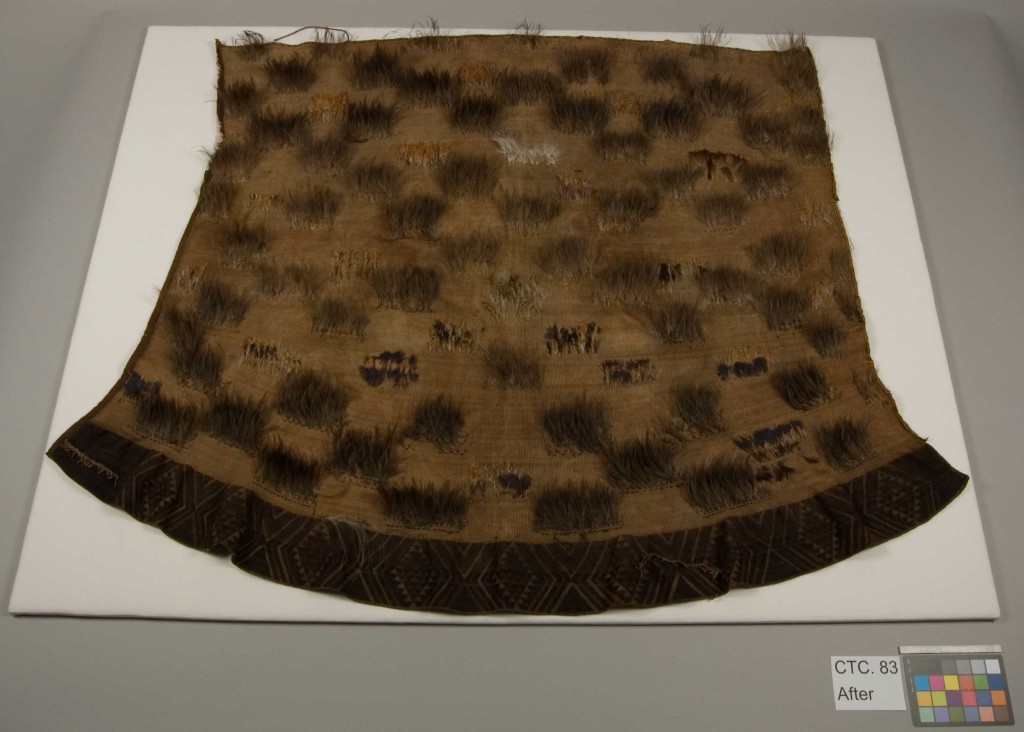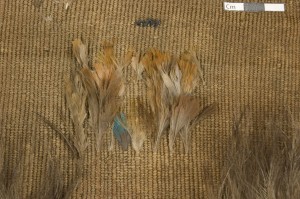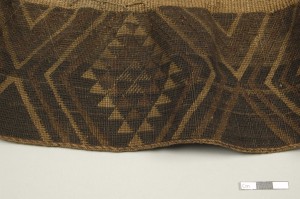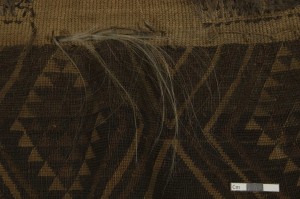
by Melissa Bolin, second year student, MPhil Textile Conservation.
As part of my second year studies I was given the opportunity to work on a Māori Cloak, or kākahu (GLAHM E.422) now in the collection at The Hunterian. The cloak is originally from New Zealand and is likely to be an eighteenth century example collected during the Cook voyages. Captain John Laskey, author of the Hunterian’s first catalogue ‘A General Account of the Hunterian Museum’ published in 1813, refers to what is likely to be this cloak as a “flaxen mantle” displayed with other “admirable and curious articles collected during the voyages of Captains Cook, King, &c. in the South Seas” in Glass Case, No. 2 (p20).
The brief for the project was to make the cloak safe for storage and access and to investigate the potential for cleaning and stabilisation, but one of the most fascinating aspects was gaining an understanding of the techniques and materials used to construct the cloak.

The cloak is woven using a twining technique from New Zealand flax, a native New Zealand plant. The bottom section of the cloak is called a tāniko. It is dyed with natural dyes that produce shades of black and brown that can be used to create a pattern. It is decorated with groups of feathers from a number of different birds also native to New Zealand. The distinctive and extremely rare feature of these feathers is that they are ‘upward facing’ – an orientation found on only one other cloak in existence, making this an internationally significant artefact. There is also a small amount of skin and hair most likely from a Pacific dog, now extinct.
Detail of tāniko and kuri hair © University of Glasgow
The majority of the feathers on the cloak are from the Kiwi bird, a small flightless brown bird indigenous to New Zealand. There are other cloaks in museums around the world entirely covered in kiwi feathers, known as kahu kiwi. This cloak however used other feathers along with the kiwi feathers to create a pattern on the surface of the cloak. The other feathers in blue, white, black, orange and green come from a variety of large forest dwelling parrots such as the kākā and kākāpo. A visit to the lab by University of Glasgow Professor of Zoology David Houston, gave me a fascinating insight into these rare and rather strange birds.

While investigating the cloak I discovered one small turquoise blue feather hidden among a section of orange feathers. This was the only feather of this type on the cloak and it struck me as interesting that it was hidden behind or among the other feathers . Research revealed that this is a common feature of these kākahu and it is suggested that these individual feathers may be placed there by the weaver as a sign, perhaps as something similar to a maker’s mark.

I also looked into information on the skin and hair that decorate the cloak. The hair is from a now extinct dog, the kurī, native to the Pacific region, which the Māori took with them to New Zealand. The kurī was considered a very high status animal to own, and as it became rarer in the late 18th and early 19th centuries smaller sections of kurī skin were used to decorate cloaks. Their high status and rarity meant that cloaks decorated with kurī hair were made for only people of high rank in society.
Conservation of the cloak focussed on storage and stabilisation. Due to its size, the cloak had been folded in storage and this had caused the feathers on the half of the cloak on the bottom of the box to become flattened. There was also a significant central crease and stress to feathers positioned on the fold. It was considered important to reduce this crease as much as possible as well as devise a way of allowing the cloak to be stored flat.
It was decided through discussion with Hunterian Museum, Curator of Archaeology Dr Sally-Anne Coupar that it was important that the cloak be stored flat and to be accessible for research, something that is likely as the historic Māori cloaks in The Hunterian are often requested for study by contemporary Māori weavers. A padded board was made that would allow staff to carry the cloak with minimal handling and as the cloak is no longer to be stored folded, the whole front of the cloak can be studied with little handling. A box was then made to contain the cloak on its padded board. This box protects the cloak from dust or from the risk of heavy objects being placed on it in storage.
It was a great opportunity to work with such a rare and significant piece of history and a useful experience to deal with the reality of storage and access of large objects. Knowing that completing this treatment successfully means the cloak is now safe for further generations to enjoy and study is very satisfying.




Yay, I’m so glad you got to do something with this! And I’m really glad it’s being stored flat now. Did you end up doing any humidification of the crease, or did you just leave it to relax out under ambient conditions?
Thanks for your comment. Yes, a small amount of moisture was introduced into the fibres of the cloak along the fold using a cold poultice. The method was quite effective as the fibres were receptive to the addition of the moisture and the cloak is much improved in both appearance and risk of further damage.